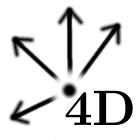Special Relativity
Lorentz Transformation
The following derivation is based on the lecture notes of
Victor M. Yakovenko, which I found online. I was initially stuck on the logic of Eq. 14 in Yakovenko's derivation; however, his approach took me past the point where I was stuck in Einstein's derivation. By combining the initial setup of Yakovenko's derivation with my interpretation of Einstein's
derivation, I was able to derive the Lorentz transformation in a way which I can somewhat understand. The explanation in section 4 below may be slightly misleading. I believe the math is correct, and the section will be revised in the future. In this derivation, I introduce the principle of relativity using the matrix inverse, and the constancy of the speed of light is assumed.
We seek a linear transformation of \( \begin{pmatrix} x \\ t \end{pmatrix} \) which will tell us \( \begin{pmatrix} x' \\ t' \end{pmatrix} \), where the primed frame is moving at a constant velocity \(v\) relative to the unprimed frame. Assuming at \(t=0\) that their origins coincide.
$$
\begin{align*}
\begin{pmatrix} x' \\ t' \end{pmatrix} &= \begin{pmatrix} A & B \\ C & D \end{pmatrix} \begin{pmatrix} x \\ t \end{pmatrix}\\
&= L \begin{pmatrix} x \\ t \end{pmatrix}
\end{align*}
$$
1
When \(x=vt\) then \(x'=0\). Simply put, a point moving at velocity \(v\) in the unprimed frame appears stationary in the primed frame.
$$
\begin{align*}
0 &= Avt + Bt\\
B &= -Av\\
x' &= Ax - Avt\\
x' &= A(x-vt) \tag{1}
\end{align*}
$$
2
When \(x'=-vt\) then \(x=0\). Or, a point moving with velocity \(-v\) in the primed frame appears stationary in the unprimed frame. We start with Eq. 1. and also use \(t' = Cx + Dt\) from our linear transformation, to show that \(A = D\)
$$
\begin{align*}
-vt' &= A(-vt)\\
t' &= Dt\\
A &= \frac{t'}{t}\\
D &= \frac{t'}{t}\\
A &= D
\end{align*}
$$
3
Let \(F = \frac{C}{A}\). Then combine Eq. 1, 2 to form a linear system with 2 unknowns A, F. The principle of relativity can now be introduced to solve for F.
$$
\begin{align*}
t' &= Cx + At\\
t' &= A\begin{pmatrix}\frac{C}{A} x + t\end{pmatrix} \tag{2}\\
\begin{pmatrix}x'\\t'\end{pmatrix}&= A \begin{bmatrix}1 & -v\\F & 1\end{bmatrix} \begin{pmatrix}x\\t \end{pmatrix}\tag{3}
\end{align*}
$$
Invert the linear system in Eq. 3 to find Eq. 4. While this step can be verified using MATLAB or Octave, it's straightforward to derive using Gaussian Elimination to arrive at Eq. 4.
$$
\begin{align*}
\begin{pmatrix}x\\t\end{pmatrix} = \frac{1}{A(1+vF)} \begin{bmatrix} 1 & v \\ -F & 1 \end{bmatrix} \begin{pmatrix}x'\\t' \end{pmatrix} \tag{4}
\end{align*}
$$
4
Apply the principle of relativity to the measurement of lengths. We don't know how the primed frame will view lengths in the unprimed frame, but we know that it will be the same as however the unprimed frame views lengths in the primed frame. Consider at \(t=0\).
$$
\begin{align*}
\begin{pmatrix}x\\t \end{pmatrix} &= \begin{pmatrix}1\\0 \end{pmatrix}\\
x' &= A
\end{align*}
$$
In the other reference frame:
$$
\begin{align*}
\begin{pmatrix}x'\\t' \end{pmatrix} &= \begin{pmatrix}1\\0 \end{pmatrix}\\
x &= \frac{1}{A(1+vF)}
\end{align*}
$$
Since neither frame is a privileged observer, both frames must view each other in the same way. \(x'\) must equal \(x\) though we don't know what either equals. This allows the derivation to proceed. Now Eq. 5 expresses the transformation in only a single unknown. This variable \(A\) is known as the "Lorentz Factor". We will solve for it next.
$$
\begin{align*}
A &= \frac{1}{A(1+vF)}\\
(1+vF)A^2 &= 1 = A^2 + vFA^2\\
F &= \frac{1-A^2}{vA^2}\\
\begin{pmatrix}x' \\ t'\end{pmatrix} &= A \begin{bmatrix} 1 & -v\\\frac{1-A^2}{vA^2} & 1 \end{bmatrix} \begin{pmatrix} x\\ t \end{pmatrix} \tag{5}
\end{align*}
$$
5
We will draw on the assumption that the speed of light is a constant in all reference frames. When \(\begin{pmatrix}x\\t\end{pmatrix} = \begin{pmatrix}ct\\t\end{pmatrix}\) then \(\begin{pmatrix}x'\\t'\end{pmatrix} = \begin{pmatrix}ct'\\t'\end{pmatrix}\) based on experimental observations such as
this.
$$
\begin{align*}
A (ct - vt) &= ct'\\
A\begin{pmatrix}\frac{1-A^2}{vA^2}ct + t\end{pmatrix} &= t'\\
\frac{At}{c} (c-v) &= t'\\
A\begin{pmatrix}\frac{1-A^2}{vA^2}ct + t\end{pmatrix} &= \frac{At}{c} (c-v)\\
\begin{pmatrix}\frac{1-A^2}{vA^2}c + 1\end{pmatrix} &= \frac{1}{c} (c-v)\\
c-v &= \frac{1-A^2}{vA^2}c^2 + c\\
-v &= \frac{1-A^2}{vA^2}c^2\\
\frac{-v}{c^2} &= \frac{1-A^2}{vA^2}\\
\frac{-v^2}{c^2} &= \frac{1-A^2}{A^2}\\
\frac{-v^2 A^2}{c^2} + A^2 &= 1\\
\begin{pmatrix}1 + \frac{-v^2}{c^2}\end{pmatrix}A^2 &= 1\\
A^2 &= \frac{1}{1 - \frac{v^2}{c^2}}\\
A &= \frac{1}{\sqrt{1-\frac{v^2}{c^2}}}
\end{align*}
$$
6
Returning to Eq. 5 we can simplify the transformation further.
$$
\begin{align*}
g &= 1-\frac{v^2}{c^2}\\
\frac{1-A^2}{vA^2} = \frac{1-\frac{1}{g}}{v\frac{1}{g}} &= \frac{\frac{g}{g} - \frac{1}{g}}{\frac{v}{g}} = \frac{g-1}{v} = \frac{\frac{-v^2}{c^2}}{v} = \frac{-v}{c^2}\\
\begin{pmatrix}x' \\ t'\end{pmatrix} &= A \begin{bmatrix} 1 & -v\\ \frac{-v}{c^2} & 1 \end{bmatrix} \begin{pmatrix} x\\ t \end{pmatrix} = L \begin{pmatrix} x\\ t \end{pmatrix} \tag{6}
\end{align*}
$$
Lastly multiplying the bottom row by c gives a symmetric matrix, the same form arrived at by Yakovenko.
$$
\begin{align*}
\begin{pmatrix}x' \\ ct'\end{pmatrix} &= A \begin{bmatrix} 1 & \frac{-v}{c}\\ \frac{-v}{c} & 1 \end{bmatrix} \begin{pmatrix} x\\ ct \end{pmatrix}
\end{align*}
$$

